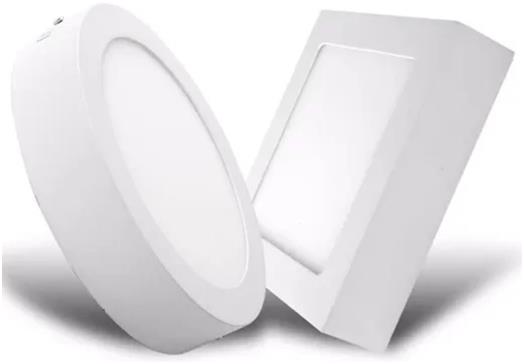Do you know the principle and development history of LED lights?
How much do you know about the history of LED lights? How much do you know about the principle of LED lighting? In this article, LED lamp manufacturer Xinjielighting will introduce the light-emitting principle and development history of LED lights in detail, and help you understand the past and present of LED lights and the root cause of LED lights.
1. The principle of LED lights
LED (Light Emitting Diode), light-emitting diode, is a solid-state semiconductor device that can convert electrical energy into visible light, and it can directly convert electricity into light. The heart of LED is the wafer of a semiconductor, and one end of wafer is attached on a bracket, and one end is negative pole, and the other end connects the positive pole of power supply, and whole wafer is encapsulated by epoxy resin.
Semiconductor wafer is made up of two parts, and a part is P-type semiconductor, and hole occupies an leading position in it, and the other end is N-type semiconductor, and here mainly is electron. But time these two kinds of semiconductors couple together, between them, just form a P-N junction. When electric current acts on this chip by wire time, electron will be pushed to P district, and in P district, electron is recombined with hole, then will send energy with the form of photon, the principle of LED light that Here it is. And the wavelength of light i.e. the color of light, be determined by the material forming P-N junction.
LEDs can directly emit red, yellow, blue, green, blue, orange, purple, and white light.
Initially, LEDs were used as indicating light sources for instruments and meters. Later, LEDs of various light colors were widely used in traffic lights and large-area display screens, resulting in good economic and social benefits. Take the 12-inch red traffic light as an example. In the United States, a long-life, low-light 140-watt incandescent lamp was originally used as the light source, which produces 2000 lumens of white light. After passing through the red filter, 90% of the light is lost, leaving only 200 lumens of red light. In the newly designed lamp, Lumileds uses 18 red LED light sources, including circuit loss, and consumes a total of 14 watts of power to produce the same light effect. Automobile signal lights are also an important field of application of LED light sources.
For general lighting, people need more white light sources. In 1998, the LED that emits white light was successfully developed. The LED is made by packaging a GaN chip with yttrium aluminum garnet (YAG). The GaN chip emits blue light (λp=465nm, Wd=30nm), and the YAG phosphor powder containing Ce3+ produced by high-temperature sintering is excited by the blue light and emits yellow light with a peak value of 550nm. The blue LED substrate is installed in a bowl-shaped reflective cavity, covered with a thin layer of resin mixed with YAG, about 200-500nm. Part of the blue light emitted by the LED substrate is absorbed by the phosphor, and the other part of the blue light is mixed with the yellow light emitted by the phosphor to obtain white light.

For InGaN/YAG white LEDs, by changing the chemical composition of the YAG phosphor and adjusting the thickness of the phosphor layer, white light of various colors with a color temperature of 3500-10000K can be obtained. This method of obtaining white light through blue LEDs has a simple structure, low cost, and high technical maturity, so it is most widely used.
2. History of LED lights
1. Origin
In the 1960s, scientific and technological workers developed LED light-emitting diodes by using the principle of semiconductor PN junction to emit light. The LED developed at that time was made of GaASP, and its luminous color was red. After nearly 30 years of development, LEDs, which everyone is very familiar with, can emit red, orange, yellow, green, blue and other colors of light. However, the white light LED used for lighting was only developed after 2000. Here I will introduce the white light LED for lighting to readers.
2. Development
The earliest LED light source made by applying the principle of semiconductor P-N junction light emission came out in the early 1960s. The material used at that time was GaAsP, which emitted red light (λp=650nm). When the driving current was 20 mA, the luminous flux was only a few thousandths of lumens, and the corresponding luminous efficacy was about 0.1 lumens/watt.
In the mid-1970s, the elements In and N were introduced to make the LED produce green light (λp=555nm), yellow light (λp=590nm) and orange light (λp=610nm), and the light performance was also increased to 1 lumen/watt.
In the early 1980s, GaAlAs LED light sources appeared, making the luminous efficacy of red LEDs reach 10 lumens/watt.
In the early 1990s, GaAlInP, which emits red and yellow light, and GaInN, which emits green and blue light, were successfully developed, which greatly improved the luminous efficacy of LEDs.
In 2000, the luminous efficacy of LEDs made by the former reached 100 lumens/watt in the red and orange regions (λp=615nm), while the luminous efficacy of LEDs made by the latter reached 50 lumens in the green region (λp=530nm). /watt.
3. Lighting memorabilia
— Edison invented the electric light in 1879;
—1938 Fluorescent lamps came out;
—1959 Halogen lamp came out;
—1961 High pressure sodium lamp came out;
—1962 metal halide lamps;
—1969 The first LED light (red);
—1976 Green LED lights;
—1993 blue LED lights;
—1999 White LED lights;
—2000 LEDs are used in indoor lighting.
—The development of LED is the second revolution after the 120-year history of the development of incandescent lighting.
—Beginning in the 21st century, the LED developed through the wonderful encounter between nature, human beings and science will become an innovation in the light world, a green technology light revolution essential to human beings.
—LED will be a huge light revolution since Edison invented the light bulb.
LED lights are mainly high-power white LED single lights. The world's top three LED lighting manufacturers have a three-year warranty. The large particles are 100 lumens per watt or more, and the small particles are 110 lumens per watt or more. The light decay of large particles is less than 3% per year, and the light decay of small particles is less than 3% per year.
LED solar street lights, LED spotlights, LED ceiling lights, and LED fluorescent lights are all ready for mass production. For example, a 10-watt LED fluorescent lamp can replace a 40-watt ordinary fluorescent lamp or an energy-saving lamp.
Nowadays, more and more LED energy-saving lamps have entered the homes of ordinary people, and they have also become the first choice for all walks of life!







